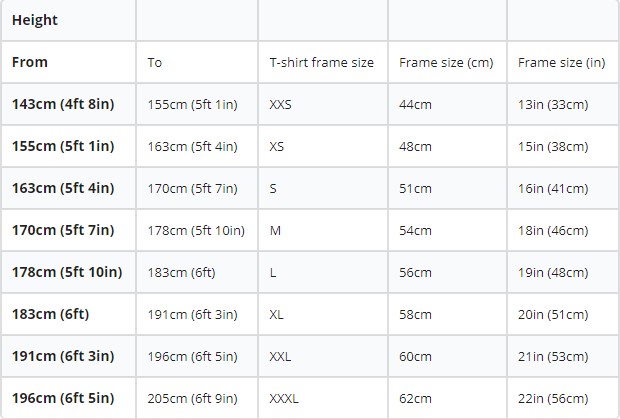Choosing the right bike frame size is a crucial step in ensuring a comfortable and efficient cycling experience. The bike frame size refers to the dimensions of the bicycle frame, primarily determined by the length of the top tube, seat tube, and standover height.
Selecting the correct bike frame size is vital for several reasons. A well-fitted bike enhances comfort, reduces the risk of injury, and improves overall performance. Riding a bike with an improper frame size can lead to discomfort, fatigue, and even musculoskeletal issues over time.
Why Bike Frame Size Matters
Bike frame size matters for several reasons, all of which contribute to your comfort, efficiency, and safety while riding:
- Comfort: A bike that’s the right size for your body will be more comfortable to ride. A properly sized frame ensures that you’re in a position where you can efficiently pedal without straining your muscles or putting excessive pressure on your joints.
- Efficiency: A bike that fits you well allows you to transfer power to the pedals more effectively. If the frame is too large or too small, you may not be able to achieve an optimal pedaling position, which can decrease your efficiency and make it harder to maintain speed and endurance.
- Handling: Proper frame size affects how the bike handles. A frame that’s too large or too small can impact your ability to control the bike, especially when cornering or navigating tight spaces. With the right frame size, you’ll have better control over the bike, enhancing your overall riding experience.
- Safety: Riding a bike that’s the wrong size can be unsafe. A frame that’s too large may make it difficult for you to reach the ground with your feet, which can increase the risk of accidents, especially when stopping or maneuvering at slow speeds. Conversely, a frame that’s too small can cause discomfort and may lead to overextension or loss of control.
- Injury Prevention: Riding a bike that doesn’t fit properly can lead to a range of injuries, including strains, sprains, and even more serious issues like nerve damage or joint problems. A bike that’s the right size for your body minimizes the risk of injury by allowing you to maintain proper posture and biomechanics while riding.
Overall, choosing the right bike frame size is essential for maximizing your comfort, performance, and safety on the road or trail. It’s worth taking the time to find a bike that fits you well and, if necessary, consulting with a professional at a bike shop to ensure you get the right fit for your body and riding style.
Understanding Bike Frame Size
Components of a Bike Frame
- Top Tube: The horizontal tube connecting the bike’s head tube to the seat tube. Its length plays a crucial role in determining the bike’s reach and overall fit.
- Seat Tube: The vertical tube running from the bike’s bottom bracket to the seat post. The length of the seat tube affects the rider’s leg extension and posture.
- Standover Height: The distance between the top tube and the ground when standing over the bike. It is a key measurement for ensuring proper clearance.
Sizing Standards in the UK
- Metric vs. Imperial Measurements: Understanding whether a bike’s dimensions are provided in metric or imperial units is essential for accurate interpretation.
- Common Size Ranges: Familiarizing oneself with the typical size ranges for different types of bikes helps in narrowing down options.
Determining Your Ideal Bike Frame Size
Measuring Inseam Length:
Your inseam length is a crucial factor in determining the ideal frame size. Here’s how to measure it accurately:
- Step-by-Step Guide:
- Stand barefoot with your back against a wall.
- Place a level book or block between your legs, snug but not tight.
- Mark the wall where the top of the book touches it.
- Measure the distance from the mark to the ground using a measuring tape.
- Tips for Accuracy:
- Ensure you stand level and maintain proper posture.
- Repeat the measurement for consistency.
Considering Riding Style and Comfort:
- Road Bikes vs. Mountain Bikes:
- Road bikes typically have a more aggressive geometry with a lower standover height for a performance-oriented posture.
- Mountain bikes prioritize comfort and control on uneven terrain, often featuring a higher standover height and a more upright riding position.
- Importance of Proper Fit: While the inseam method provides a starting point, consider your riding style and comfort preferences.
- A more aggressive rider might choose a slightly smaller frame size for a lower and more aerodynamic position.
- A rider prioritizing comfort might opt for a slightly larger frame for a more upright posture.

Image source: ilovebicycling
Sizing Charts and Calculators
Overview of Standard Bike Size Charts
- Manufacturer-specific Charts: Different bike manufacturers may have variations in their sizing charts. Exploring these charts aids in finding a suitable frame size.
- Generic Size Guides: Generic size guides offer a starting point for selecting a bike size based on height and inseam length.
Online Calculators and Tools
- Input Parameters: Understanding the information required for online calculators, including height, inseam length, and riding style.
- Interpretation of Results: Interpreting the results obtained from online tools and adjusting for personal preferences and comfort.

Image source: bikeradar
Adjustments and Fine-Tuning
Bike Frame Adjustments
- Saddle Height: Proper adjustment of saddle height to achieve optimal leg extension during pedaling.
- Handlebar Position: Fine-tuning the handlebar position for comfort and control.
Seeking Professional Advice
- Bike Fit Services: Overview of professional bike fitting services and their benefits.
- Consulting with Experts: Discuss bike fit concerns with experienced cyclists or professionals for personalized advice.
Common Pitfalls to Avoid
Ignoring Standover Height
Highlighting the potential issues that can arise from neglecting standover height when selecting a bike.
Overlooking Riding Style
Emphasizing the importance of choosing a frame size that aligns with the rider’s intended style of cycling, whether it’s commuting, racing, or off-road adventures.
Neglecting Comfort Factors
Addressing the significance of overall comfort and how it contributes to a more enjoyable and sustainable cycling experience.
Conclusion:
Mastering the art of measuring your bike frame size in the UK is paramount for a superior cycling experience. By understanding the intricacies of the top tube, seat tube, and standover height, considering your inseam length, and factoring in your riding style, you pave the way for a comfortable and efficient ride.
Don’t overlook the value of utilizing sizing charts, online calculators, and, most importantly, taking advantage of test rides at local bike shops. Fine-tuning your bike frame adjustments and seeking professional advice can make a substantial difference.
Remember, the right bike frame size isn’t just a measurement; it’s your key to unlocking a world of cycling enjoyment and minimizing the risk of discomfort or injury. Happy cycling!
Frequently Asked Questions (FAQs)
Measure your inseam length by standing with your feet shoulder-width apart and using a tape measure from your crotch to the ground. Check manufacturer sizing charts or use online calculators, considering your riding style, to find the recommended frame size.
The term “26-inch” refers to the diameter of the wheels on the bike. This size was standard for many mountain bikes in the past. It’s essential to note that wheel size doesn’t directly determine the frame size, so measure the frame separately for a perfect fit.
A 17-inch bike frame typically refers to the length of the seat tube. Measure this length from the bike’s bottom bracket to the top of the seat tube. Keep in mind that sizes can vary between manufacturers, so consult their sizing charts for accurate guidance.
Determine your frame size by measuring your inseam length and using manufacturer-specific sizing charts or online calculators. Consider your riding style (road or mountain), as different styles may require different frame geometries. Test rides at local bike shops can also help you feel which size suits you best.
